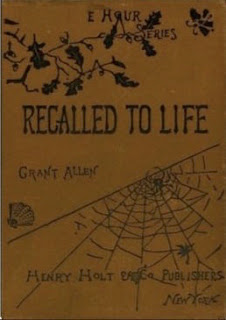Over pints this past weekend, I remarked to a friend that I'd just begun reading my thirteenth Grant Allen novel. This friend responded that he'd never heard of the man, but was very interested. I think it was the drink.
"Where's the best place to start?" my friend asked. Where indeed! Allen published over seventy titles in his fifty-one years. My good fortune was that the first I read, Michael's Crag, was so good that I wanted more.
Describing Grant Allen as nineteenth-century Canada's greatest novelist may seem a bit much, but who else did we have? Robert Barr is very nearly as good, May Agnes Fleming is wonderfully entertaining. Who else? Sir Gilbert Parker? Sir Charles G.D. Roberts?
Allen was a writer of great imagination; he created memorable characters and had a dab hand at clever, intricate plots. What's more, he never hesitated in introducing social commentary to his fiction (see: The Woman Who Did and The British Barbarians). I think so much of the man that I devoted the first section of my most recent book, The Dusty Bookcase, to Allen.
With twelve Allen titles tackled – and nearly sixty to go – my interest in Allen remains strong. I have no doubt that I'll read every novel the man wrote before I leave This Mortal Coil (title of the first of his three 1888 novels). What follows are the ten best Allen novels tackled to date, in order of preference. Five of the ten are covered in The Dusty Bookcase book. Links to my online reviews of the other five are provided.
The Devil's Die (1888)
The story of upstanding Muslim doctor Muhammed Ali and his gradual realization that friend and fellow physician Harry Chichele is a psychopathic murderer. The novel shocked George Bernard Shaw, influencing his 1893 play The Philanderer.
For Maimie's Sake (1886)
Of Allen's "commercial" novels, For Mamie's Sake stands as the only one he wouldn't dismiss in conversations with friends. Am I wrong in thinking it a satire? For Mamie's Sake is not recognized as such. Either way, it's the most humorous Allen I've read to date. Black humour, of course.
Michael's Crag (1893)
A civil servant is struck on the head by falling rock and comes to believe he is the Archangel Michael. His suffering wife struggles to keep him in check until their daughter can be married off. It all ends very badly, but not in a way that anyone could've anticipated.
What's Bred in the Bone (1891)
Identical twin brothers of unknown origin embark on very different paths, one of which leads to forgery and fraud. What's Bred in the Bone was awarded £1000 as best serial story by Tit-Bits magazine. If that doesn't entice, I'll add that it is the most sexual Allen book I've read this far.
Under Sealed Orders (1895)
A child is groomed to be a self-sacrificing political assassin only to fall in love with a New Woman adventuress as a young man. Murder is now out of the question, which isn't to suggest that it doesn't happen just the same.
Hilda Wade (1900)
Grant Allen's last novel. On his deathbed, the author told the conclusion to his friend Arthur Conan Doyle, who then wrote the final chapters. The resulting book, profusely illustrated, was published posthumously with obvious affection. But don't think its appearance swayed my judgement; Hilda Wade is a strong novel, centred on the strongest of Allen's women.
The British Barbarians (1895)
The story of a time traveller's visit to Victorian England, this novel is short on plot but long on acute, clever, and cutting social commentary. I'm beginning to wonder whether it shouldn't be higher on the list. Perhaps so. At the very least, it's worth rereading and reconsidering.
Recalled to Life (1891)
A mystery in which a significant advancement in photography plays a key role, like so very many Allens its protagonist is a young woman. Moved up a notch because it is one of the few Allens that takes place in Canada. Quebecers and British Columbians will be the most satisfied.
The Type-Writer Girl (1897)
Late in his brief life, Allen wrote several novels narrated by New Woman protagonists. Of these, The Type-Writer Girl holds a special place in having been published under a female pseudonym. This slight novel concerns a Girton girl who looks to support herself through office work. Agrarian anarchists feature.
The Cruise of the Albatross (1890)
An adventure story for boys, complete with cannibals, human sacrifice, sea travel, and a twist that owes everything to Jules Verne's Around the World in Eighty Days. I remain thankful that I didn't read it first.
Why have I not included The Woman Who Did, the scandalous novel for which Allen is best remembered?
The answer is simple: I ain't read it yet.
A bonus: The two novels that didn't make the Top Ten:
Related posts:























































